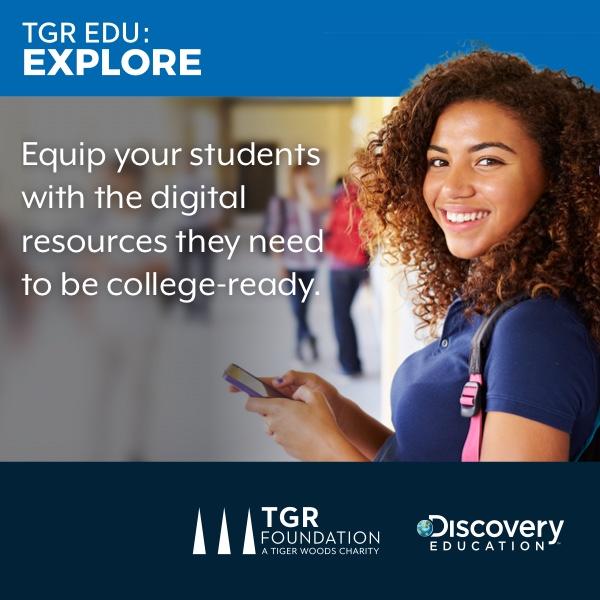Reduce Barriers to College Entry With Scholarship Support for Your Students
By Michael C. Knowlton, Professional Learning Specialist, Santa Rosa Schools

Scholarships are a valuable resource that can help ease the path to higher education. The scholarship application process is critical, but may be unfamiliar to students and their families.
As teachers, students rely on us to be a reliable support system when preparing for college, making it imperative that we help students understand how to leverage scholarships. Programs such as TGR EDU: Explore, developed by TGR Foundation, A Tiger Woods Charity, in partnership with Discovery Education, provide no-cost resources to help students prepare for college.
Here are four objectives educators should have students focus on in preparation for the scholarship application process.
#1 Identify the different types of scholarships that are available.
There are two general categories of scholarships, merit and financial need. Here’s a quick explanation of each:
· Merit scholarships are awarded based on a student’s individual accomplishments, which may be academic, athletic or artistic.
· Financial need scholarships take a student and their family’s financial situation into account. To take advantage of these, it’s critical that the Free Application for Student Aid (FAFSA) is submitted on time.
It’s also important to help students understand how to identify authentic scholarship opportunities. Scholarship red flags include:
· Exorbitant application fees, or “exclusive” access to an application if you pay a fee.
· “Guaranteed” acceptance.
· No scholarship provider information listed.
· Suspicious websites (typos, outdated information and broken links are a few clues).
· Applications that require too many details, such as credit card information or a social security number.
Besides using scholarship resources from their school, BigFuture from College Board and Fastweb are two websites that list trusted scholarship opportunities. Students can also use the IRS website to see if a tax-exempt organization is legitimate.
#2 Describe strategies to highlight your unique skills, talents, abilities and experiences.
Have students reflect on what makes them unique. Skills, talents, extracurriculars and background are all fair game. It’s important that students understand the breadth of scholarships that are available.
Academic resumes, high school transcripts, lists of volunteer experience, extracurricular involvement and any other achievements are both important for the application process itself, and for helping students identify their strengths.
#3 Analyze sample applications based on scholarship criteria.
Walking students through sample applications helps to form an idea of what a satisfactory application looks like. TGR EDU: Explore provides a good example in the Scholarship Case Study lesson plan.
Examples should include a general idea of the information students will need, such as their living situation, guardians’ careers, as well as potential essay questions and responses. It’s also important to make sure students understand how to prepare an academic resume and how to request a copy of their high school transcripts.
#4 Discover tools to find scholarships that are a good fit.
In addition to the Scholarship Case Study lesson mentioned above, College Blueprint and Financial Pur$uit are two other TGR EDU: Explore resources covering scholarships.
With the right resources and support, every student has an opportunity to reduce the financial barriers that inevitably come with pursuing higher education. Use this guide to support your students in utilizing the resources available to them.

